Reality Check: Who Makes the Rules? Essay
People often face situations that are controlled by different rules. Unfortunately, rules may be inhumane under circumstances in which people may appear. Such a situation happened to Mr. Jones who was trying to get home after a long trip. The case study “Reality Check: Who Makes the Rules?” on page 33 in Chapter 1 discusses his situation. Mr. Jones had an ailing wife. Mrs. Jones was ill for a few years, and her condition was complicated. Besides, Mrs. Jones experienced severe pains. In this situation, it is very clear why Mr. Jones was in a hurry to get home as soon as possible. However, in the airport, Mr. Jones did not find any manager who could be compassionate to his situation. For this reason, he had to wait extra time before he could get on board his plane. This sad situation shows that at times rules should be avoided which is important for the well-being of people because people are more important than rules.
Evaluating the situation that Mr. Jones had to face, and the way the personnel of the airport responded to his needs, it becomes evident that rules do not always work for the good. It is true that rules are important for order in different establishments, but there should be common sense behind them. Mangers whose work is connected to following rules should have the freedom to avoid rules if it is necessary for the well-being of their clients. It is possible that all the three managers who talked to Mr. Jones had compassion for him, but their freedom of action was limited by the airport rules. This precedent proves the importance of reassessing the policies which control the work of so many establishments. In such policies, force majeure situations should be taken into consideration.
Reflecting on what Mr. Jones had to go through, a conclusion can be made that the rules were inconsistently applied in this reality check. Of course, the rules mentioned by the managers that Mr. Jones approached were reasonable and important for order compliance, but it is absolutely evident that the situation in which Mr. Jones appeared was very different from the situations which are governed by such rules. The rules mentioned by the managers of the airport are aimed for controlling those clients who do not have emergent situations. Ethical principles show that people who appeared in emergencies such as Mr. Jones’ one have the right to be served in the way they need. The whole point of any rule or regulation, and the main idea behind them is to make people’s life better. If any rule does not meet this requirement, it may be automatically considered inconsistently applied. If the person applies the letter or the specific statement of the rule rather than its spirit, there are no doubts that there will occur situations in which this rule will be not a blessing, but a malediction for people. Ethical codes and the rules of morality are beyond any regulation, law or rule when the state of affairs requires so. Rules are created to be the guidance for people, but they are not sacred laws that must be obeyed in any case. In addition, there happen contradictory situations when two rules are acting against each other. In such situations, it is better to choose the lesser of the evils.
- Chicago (A-D)
- Chicago (N-B)
IvyPanda. (2022, February 2). Reality Check: Who Makes the Rules? https://ivypanda.com/essays/reality-check-who-makes-the-rules/
"Reality Check: Who Makes the Rules?" IvyPanda , 2 Feb. 2022, ivypanda.com/essays/reality-check-who-makes-the-rules/.
IvyPanda . (2022) 'Reality Check: Who Makes the Rules'. 2 February.
IvyPanda . 2022. "Reality Check: Who Makes the Rules?" February 2, 2022. https://ivypanda.com/essays/reality-check-who-makes-the-rules/.
1. IvyPanda . "Reality Check: Who Makes the Rules?" February 2, 2022. https://ivypanda.com/essays/reality-check-who-makes-the-rules/.
Bibliography
IvyPanda . "Reality Check: Who Makes the Rules?" February 2, 2022. https://ivypanda.com/essays/reality-check-who-makes-the-rules/.
- Force Majeure Concept
- Re-Assessing Family Valuables
- Characteristics of Irish Hagiography
- The Cold War: Reassessing the Cold War and the Far-Right
- Reassessing Finance: Main Theories
- Organization Change Management and Role of Mangers in Change
- Acute Lymphocytic and Myelogenous Leukemia in Children
- The Use of the Words ‘Women’ and ‘Girls’
- Aggressive Behavior in Children
- The Ground-Level Results of Welfare Reform
- Experience of Becoming a Successful Outdoor Leader
- My Ideal Career: Personal Dream
- Balancing Work, Studying, Classes, and Social Life
- Thinking Critically and Logically For Better Understanding and Living
- The Peace Corps Impact on Human Life
- Cambridge Dictionary +Plus

Meaning of reality check in English
Your browser doesn't support HTML5 audio
- against all expectations phrase
- dumbfounding
- dumbfoundingly
- earth-shaking
- earth-shattering
- one for the books idiom
- pull something out of a/your hat idiom
- raise (a few) eyebrows idiom
- sensationalist
- turn-up for the book(s) idiom
- unbelievable
- walk in on someone
- world-shattering
reality check | Intermediate English
Examples of reality check, translations of reality check.
Get a quick, free translation!

Word of the Day
mum's the word
said when you tell someone, or agree with someone, to keep something a secret

Hidden in plain sight: words and phrases connected with hiding

Learn more with +Plus
- Recent and Recommended {{#preferredDictionaries}} {{name}} {{/preferredDictionaries}}
- Definitions Clear explanations of natural written and spoken English English Learner’s Dictionary Essential British English Essential American English
- Grammar and thesaurus Usage explanations of natural written and spoken English Grammar Thesaurus
- Pronunciation British and American pronunciations with audio English Pronunciation
- English–Chinese (Simplified) Chinese (Simplified)–English
- English–Chinese (Traditional) Chinese (Traditional)–English
- English–Dutch Dutch–English
- English–French French–English
- English–German German–English
- English–Indonesian Indonesian–English
- English–Italian Italian–English
- English–Japanese Japanese–English
- English–Norwegian Norwegian–English
- English–Polish Polish–English
- English–Portuguese Portuguese–English
- English–Spanish Spanish–English
- English–Swedish Swedish–English
- Dictionary +Plus Word Lists
- English Noun
- Intermediate Noun
- Translations
- All translations
To add reality check to a word list please sign up or log in.
Add reality check to one of your lists below, or create a new one.
{{message}}
Something went wrong.
There was a problem sending your report.
Thank you for visiting nature.com. You are using a browser version with limited support for CSS. To obtain the best experience, we recommend you use a more up to date browser (or turn off compatibility mode in Internet Explorer). In the meantime, to ensure continued support, we are displaying the site without styles and JavaScript.
- View all journals
- Explore content
- About the journal
- Publish with us
- Sign up for alerts
- 25 April 2024
- Correction 25 April 2024
‘Shut up and calculate’: how Einstein lost the battle to explain quantum reality
- Jim Baggott 0
Jim Baggott is a science writer based in Cape Town, South Africa. He is co-author with John Heilbron of Quantum Drama .
You can also search for this author in PubMed Google Scholar
For entangled particles, a change in one instantly affects the other, no matter how far apart they are. Credit: Volker Steger/SPL
You have full access to this article via your institution.
Quantum mechanics is an extraordinarily successful scientific theory, on which much of our technology-obsessed lifestyles depend. It is also bewildering. Although the theory works, it leaves physicists chasing probabilities instead of certainties and breaks the link between cause and effect. It gives us particles that are waves and waves that are particles , cats that seem to be both alive and dead, and lots of spooky quantum weirdness around hard-to-explain phenomena, such as quantum entanglement.
Myths are also rife. For instance, in the early twentieth century, when the theory’s founders were arguing among themselves about what it all meant, the views of Danish physicist Niels Bohr came to dominate. Albert Einstein famously disagreed with him and, in the 1920s and 1930s, the two locked horns in debate . A persistent myth was created that suggests Bohr won the argument by browbeating the stubborn and increasingly isolated Einstein into submission. Acting like some fanatical priesthood, physicists of Bohr’s ‘church’ sought to shut down further debate. They established the ‘Copenhagen interpretation’, named after the location of Bohr’s institute, as a dogmatic orthodoxy.
My latest book Quantum Drama , co-written with science historian John Heilbron, explores the origins of this myth and its role in motivating the singular personalities that would go on to challenge it. Their persistence in the face of widespread indifference paid off, because they helped to lay the foundations for a quantum-computing industry expected to be worth tens of billions by 2040.
John died on 5 November 2023 , so sadly did not see his last work through to publication. This essay is dedicated to his memory.
Foundational myth
A scientific myth is not produced by accident or error. It requires effort. “To qualify as a myth, a false claim should be persistent and widespread,” Heilbron said in a 2014 conference talk. “It should have a plausible and assignable reason for its endurance, and immediate cultural relevance,” he noted. “Although erroneous or fabulous, such myths are not entirely wrong, and their exaggerations bring out aspects of a situation, relationship or project that might otherwise be ignored.”

Does quantum theory imply the entire Universe is preordained?
To see how these observations apply to the historical development of quantum mechanics, let’s look more closely at the Bohr–Einstein debate. The only way to make sense of the theory, Bohr argued in 1927, was to accept his principle of complementarity. Physicists have no choice but to describe quantum experiments and their results using wholly incompatible, yet complementary, concepts borrowed from classical physics.
In one kind of experiment, an electron, for example, behaves like a classical wave. In another, it behaves like a classical particle. Physicists can observe only one type of behaviour at a time, because there is no experiment that can be devised that could show both behaviours at once.
Bohr insisted that there is no contradiction in complementarity, because the use of these classical concepts is purely symbolic. This was not about whether electrons are really waves or particles. It was about accepting that physicists can never know what an electron really is and that they must reach for symbolic descriptions of waves and particles as appropriate. With these restrictions, Bohr regarded the theory to be complete — no further elaboration was necessary.
Such a pronouncement prompts an important question. What is the purpose of physics? Is its main goal to gain ever-more-detailed descriptions and control of phenomena, regardless of whether physicists can understand these descriptions? Or, rather, is it a continuing search for deeper and deeper insights into the nature of physical reality?
Einstein preferred the second answer, and refused to accept that complementarity could be the last word on the subject. In his debate with Bohr, he devised a series of elaborate thought experiments, in which he sought to demonstrate the theory’s inconsistencies and ambiguities, and its incompleteness. These were intended to highlight matters of principle; they were not meant to be taken literally.
Entangled probabilities
In 1935, Einstein’s criticisms found their focus in a paper 1 published with his colleagues Boris Podolsky and Nathan Rosen at the Institute for Advanced Study in Princeton, New Jersey. In their thought experiment (known as EPR, the authors’ initials), a pair of particles (A and B) interact and move apart. Suppose each particle can possess, with equal probability, one of two quantum properties, which for simplicity I will call ‘up’ and ‘down’, measured in relation to some instrument setting. Assuming their properties are correlated by a physical law, if A is measured to be ‘up’, B must be ‘down’, and vice versa. The Austrian physicist Erwin Schrödinger invented the term entangled to describe this kind of situation.

How Einstein built on the past to make his breakthroughs
If the entangled particles are allowed to move so far apart that they can no longer affect one another, physicists might say that they are no longer in ‘causal contact’. Quantum mechanics predicts that scientists should still be able to measure A and thereby — with certainty — infer the correlated property of B.
But the theory gives us only probabilities. We have no way of knowing in advance what result we will get for A. If A is found to be ‘down’, how does the distant, causally disconnected B ‘know’ how to correlate with its entangled partner and give the result ‘up’? The particles cannot break the correlation, because this would break the physical law that created it.
Physicists could simply assume that, when far enough apart, the particles are separate and distinct, or ‘locally real’, each possessing properties that were fixed at the moment of their interaction. Suppose A sets off towards a measuring instrument carrying the property ‘up’. A devious experimenter is perfectly at liberty to change the instrument setting so that when A arrives, it is now measured to be ‘down’. How, then, is the correlation established? Do the particles somehow remain in contact, sending messages to each other or exerting influences on each other over vast distances at speeds faster than light, in conflict with Einstein’s special theory of relativity?
The alternative possibility, equally discomforting to contemplate, is that the entangled particles do not actually exist independently of each other. They are ‘non-local’, implying that their properties are not fixed until a measurement is made on one of them.
Both these alternatives were unacceptable to Einstein, leading him to conclude that quantum mechanics cannot be complete.
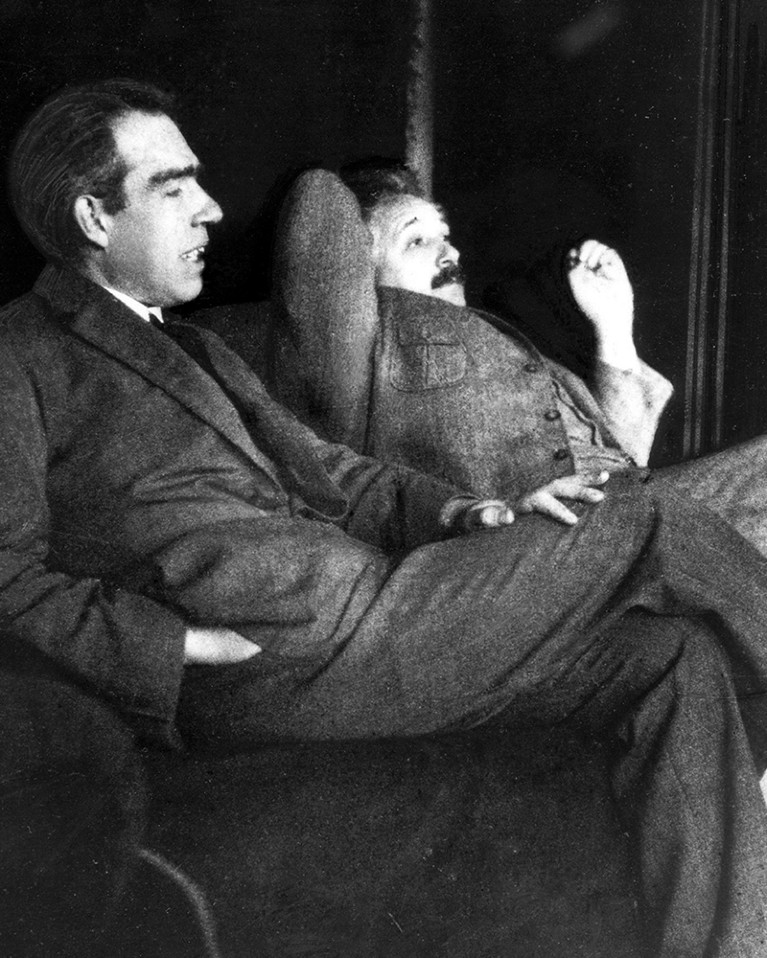
Niels Bohr (left) and Albert Einstein. Credit: Universal History Archive/Universal Images Group via Getty
The EPR thought experiment delivered a shock to Bohr’s camp, but it was quickly (if unconvincingly) rebuffed by Bohr. Einstein’s challenge was not enough; he was content to criticize the theory but there was no consensus on an alternative to Bohr’s complementarity. Bohr was judged by the wider scientific community to have won the debate and, by the early 1950s, Einstein’s star was waning.
Unlike Bohr, Einstein had established no school of his own. He had rather retreated into his own mind, in vain pursuit of a theory that would unify electromagnetism and gravity, and so eliminate the need for quantum mechanics altogether. He referred to himself as a “lone traveler”. In 1948, US theoretical physicist J. Robert Oppenheimer remarked to a reporter at Time magazine that the older Einstein had become “a landmark, but not a beacon”.
Prevailing view
Subsequent readings of this period in quantum history promoted a persistent and widespread suggestion that the Copenhagen interpretation had been established as the orthodox view. I offer two anecdotes as illustration. When learning quantum mechanics as a graduate student at Harvard University in the 1950s, US physicist N. David Mermin recalled vivid memories of the responses that his conceptual enquiries elicited from his professors, whom he viewed as ‘agents of Copenhagen’. “You’ll never get a PhD if you allow yourself to be distracted by such frivolities,” they advised him, “so get back to serious business and produce some results. Shut up, in other words, and calculate.”
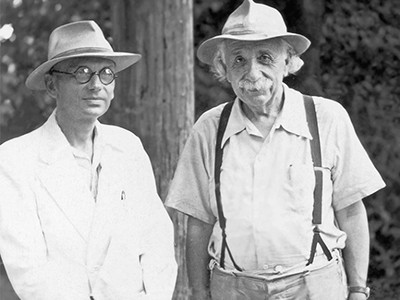
The spy who flunked it: Kurt Gödel’s forgotten part in the atom-bomb story
It seemed that dissidents faced serious repercussions. When US physicist John Clauser — a pioneer of experimental tests of quantum mechanics in the early 1970s — struggled to find an academic position, he was clear in his own mind about the reasons. He thought he had fallen foul of the ‘religion’ fostered by Bohr and the Copenhagen church: “Any physicist who openly criticized or even seriously questioned these foundations ... was immediately branded as a ‘quack’. Quacks naturally found it difficult to find decent jobs within the profession.”
But pulling on the historical threads suggests a different explanation for both Mermin’s and Clauser’s struggles. Because there was no viable alternative to complementarity, those writing the first post-war student textbooks on quantum mechanics in the late 1940s had little choice but to present (often garbled) versions of Bohr’s theory. Bohr was notoriously vague and more than occasionally incomprehensible. Awkward questions about the theory’s foundations were typically given short shrift. It was more important for students to learn how to apply the theory than to fret about what it meant.
One important exception is US physicist David Bohm’s 1951 book Quantum Theory , which contains an extensive discussion of the theory’s interpretation, including EPR’s challenge. But, at the time, Bohm stuck to Bohr’s mantra.
The Americanization of post-war physics meant that no value was placed on ‘philosophical’ debates that did not yield practical results. The task of ‘getting to the numbers’ meant that there was no time or inclination for the kind of pointless discussion in which Bohr and Einstein had indulged. Pragmatism prevailed. Physicists encouraged their students to choose research topics that were likely to provide them with a suitable grounding for an academic career, or ones that appealed to prospective employers. These did not include research on quantum foundations.
These developments conspired to produce a subtly different kind of orthodoxy. In The Structure of Scientific Revolutions (1962), US philosopher Thomas Kuhn describes ‘normal’ science as the everyday puzzle-solving activities of scientists in the context of a prevailing ‘paradigm’. This can be interpreted as the foundational framework on which scientific understanding is based. Kuhn argued that researchers pursuing normal science tend to accept foundational theories without question and seek to solve problems within the bounds of these concepts. Only when intractable problems accumulate and the situation becomes intolerable might the paradigm ‘shift’, in a process that Kuhn likened to a political revolution.

Do black holes explode? The 50-year-old puzzle that challenges quantum physics
The prevailing view also defines what kinds of problem the community will accept as scientific and which problems researchers are encouraged (and funded) to investigate. As Kuhn acknowledged in his book: “Other problems, including many that had previously been standard, are rejected as metaphysical, as the concern of another discipline, or sometimes as just too problematic to be worth the time.”
What Kuhn says about normal science can be applied to ‘mainstream’ physics. By the 1950s, the physics community had become broadly indifferent to foundational questions that lay outside the mainstream. Such questions were judged to belong in a philosophy class, and there was no place for philosophy in physics. Mermin’s professors were not, as he had first thought, ‘agents of Copenhagen’. As he later told me, his professors “had no interest in understanding Bohr, and thought that Einstein’s distaste for [quantum mechanics] was just silly”. Instead, they were “just indifferent to philosophy. Full stop. Quantum mechanics worked. Why worry about what it meant?”
It is more likely that Clauser fell foul of the orthodoxy of mainstream physics. His experimental tests of quantum mechanics 2 in 1972 were met with indifference or, more actively, dismissal as junk or fringe science. After all, as expected, quantum mechanics passed Clauser’s tests and arguably nothing new was discovered. Clauser failed to get an academic position not because he had had the audacity to challenge the Copenhagen interpretation; his audacity was in challenging the mainstream. As a colleague told Clauser later, physics faculty members at one university to which he had applied “thought that the whole field was controversial”.
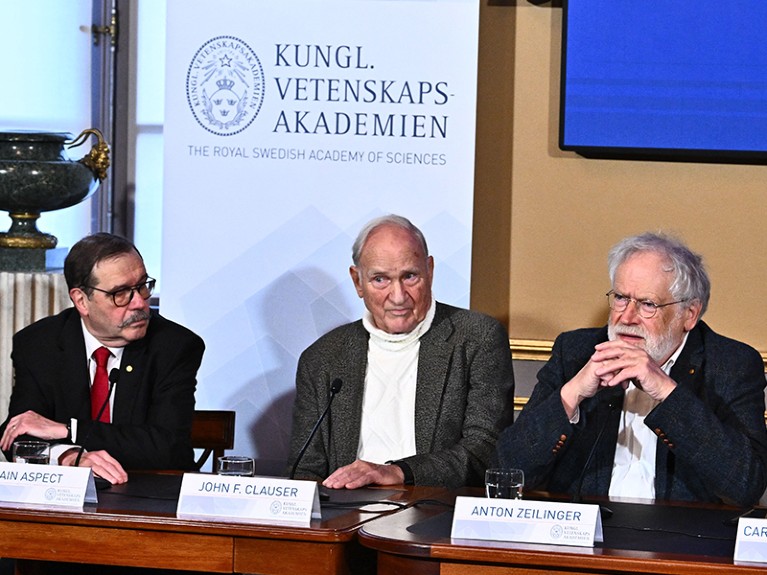
Aspect, Clauser and Zeilinger won the 2022 physics Nobel for work on entangled photons. Credit: Claudio Bresciani/TT News Agency/AFP via Getty
However, it’s important to acknowledge that the enduring myth of the Copenhagen interpretation contains grains of truth, too. Bohr had a strong and domineering personality. He wanted to be associated with quantum theory in much the same way that Einstein is associated with theories of relativity. Complementarity was accepted as the last word on the subject by the physicists of Bohr’s school. Most vociferous were Bohr’s ‘bulldog’ Léon Rosenfeld, Wolfgang Pauli and Werner Heisenberg, although all came to hold distinct views about what the interpretation actually meant.
They did seek to shut down rivals. French physicist Louis de Broglie’s ‘pilot wave’ interpretation, which restores causality and determinism in a theory in which real particles are guided by a real wave, was shot down by Pauli in 1927. Some 30 years later, US physicist Hugh Everett’s relative state or many-worlds interpretation was dismissed, as Rosenfeld later described, as “hopelessly wrong ideas”. Rosenfeld added that Everett “was undescribably stupid and could not understand the simplest things in quantum mechanics”.
Unorthodox interpretations
But the myth of the Copenhagen interpretation served an important purpose. It motivated a project that might otherwise have been ignored. Einstein liked Bohm’s Quantum Theory and asked to see him in Princeton in the spring of 1951. Their discussion prompted Bohm to abandon Bohr’s views, and he went on to reinvent de Broglie’s pilot wave theory. He also developed an alternative to the EPR challenge that held the promise of translation into a real experiment.
Befuddled by Bohrian vagueness, finding no solace in student textbooks and inspired by Bohm, Irish physicist John Bell pushed back against the Copenhagen interpretation and, in 1964, built on Bohm’s version of EPR to develop a now-famous theorem 3 . The assumption that the entangled particles A and B are locally real leads to predictions that are incompatible with those of quantum mechanics. This was no longer a matter for philosophers alone: this was about real physics.
It took Clauser three attempts to pass his graduate course on advanced quantum mechanics at Columbia University because his brain “kind of refused to do it”. He blamed Bohr and Copenhagen, found Bohm and Bell, and in 1972 became the first to perform experimental tests of Bell’s theorem with entangled photons 2 .
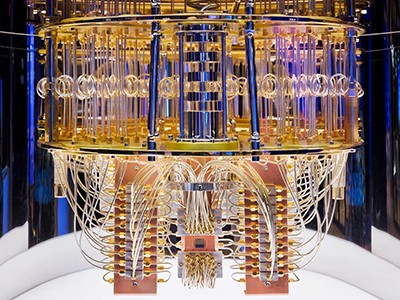
How to introduce quantum computers without slowing economic growth
French physicist Alain Aspect similarly struggled to discern a “physical world behind the mathematics”, was perplexed by complementarity (“Bohr is impossible to understand”) and found Bell. In 1982, he performed what would become an iconic test of Bell’s theorem 4 , changing the settings of the instruments used to measure the properties of pairs of entangled photons while the particles were mid-flight. This prevented the photons from somehow conspiring to correlate themselves through messages or influences passed between them, because the nature of the measurements to be made on them was not set until they were already too far apart. All these tests settled in favour of quantum mechanics and non-locality.
Although the wider physics community still considered testing quantum mechanics to be a fringe science and mostly a waste of time, exposing a hitherto unsuspected phenomenon — quantum entanglement and non-locality — was not. Aspect’s cause was aided by US physicist Richard Feynman, who in 1981 had published his own version of Bell’s theorem 5 and had speculated on the possibility of building a quantum computer. In 1984, Charles Bennett at IBM and Giles Brassard at the University of Montreal in Canada proposed entanglement as the basis for an innovative system of quantum cryptography 6 .
It is tempting to think that these developments finally helped to bring work on quantum foundations into mainstream physics, making it respectable. Not so. According to Austrian physicist Anton Zeilinger, who has helped to found the science of quantum information and its promise of a quantum technology, even those working in quantum information consider foundations to be “not the right thing”. “We don’t understand the reason why. Must be psychological reasons, something like that, something very deep,” Zeilinger says. The lack of any kind of physical mechanism to explain how entanglement works does not prevent the pragmatic physicist from getting to the numbers.
Similarly, by awarding the 2022 Nobel Prize in Physics to Clauser, Aspect and Zeilinger , the Nobels as an institution have not necessarily become friendly to foundational research. Commenting on the award, the chair of the Nobel Committee for Physics, Anders Irbäck, said: “It has become increasingly clear that a new kind of quantum technology is emerging. We can see that the laureates’ work with entangled states is of great importance, even beyond the fundamental questions about the interpretation of quantum mechanics.” Or, rather, their work is of great importance because of the efforts of those few dissidents, such as Bohm and Bell, who were prepared to resist the orthodoxy of mainstream physics, which they interpreted as the enduring myth of the Copenhagen interpretation.
The lesson from Bohr–Einstein and the riddle of entanglement is this. Even if we are prepared to acknowledge the myth, we still need to exercise care. Heilbron warned against wanton slaying: “The myth you slay today may contain a truth you need tomorrow.”
Nature 629 , 29-32 (2024)
doi: https://doi.org/10.1038/d41586-024-01216-z
Updates & Corrections
Correction 25 April 2024 : An earlier version of this Essay misnamed the Institute for Advanced Study.
Einstein, A., Podolsky, B. & Rosen, N. Phys. Rev. 47 , 777–780 (1935).
Article Google Scholar
Freedman, S. J. & Clauser, J. F. Phys. Rev. Lett. 28 , 938–941 (1972).
Bell, J. S. Phys. Phys. Fiz. 1 , 195–200 (1964).
Aspect, A., Dalibard, J. & Roger, G. Phys. Rev. Lett. 49 , 1804–1807 (1982).
Feynman, R. P. Int . J. Theor. Phys. 21 , 467–488 (1982).
Bennett, C. H. & Brassard, G. in Proc. IEEE Int. Conf. on Computers, Systems and Signal Processing 175–179 (IEEE, 1984).
Google Scholar
Download references
Competing Interests
The author declares no competing interests.
Related Articles

- Quantum physics

Intel brings quantum-computing microchips a step closer
News & Views 01 MAY 24

Allen J. Bard obituary: electrochemist whose techniques underpin clinical diagnostics, materials discovery and more
Obituary 01 MAY 24

Probing single electrons across 300-mm spin qubit wafers
Article 01 MAY 24

Probing entanglement in a 2D hard-core Bose–Hubbard lattice
Article 24 APR 24

How to stop students cramming for exams? Send them to sea
News & Views 30 APR 24

Ancient DNA traces family lines and political shifts in the Avar empire
News & Views 24 APR 24

Network of large pedigrees reveals social practices of Avar communities
Sign up for the Nature Briefing newsletter — what matters in science, free to your inbox daily.
Most Popular
13 days ago
Whose vs Who’s
Were ninjas real.
10 days ago
It’s vs Its
How to cite a report, using grammarly placed a student on academic probation, what is reality essay sample, example.

Most people do not stop to introspect about what reality really is. Usually, we use the word “reality” to mean what seems to be, or facts filtered through a biased lens. But, it seems there should be one reality. It should not be dependent on people’s perception of what reality is. Reality is not based on thoughts, feelings, and physical sensations. These three elements disrupt that perceiving of reality. So, what is reality then?
In order to perceive reality in its true form, we should not add the filter of our thoughts, feelings, and physical sensations. Reality is simply what it is—nothing more, nothing less. It is said by science that reality is what is most fundamental, and that can be expressed through mathematics. The construction of the entirety of mathematics can be done with an empty set ( The New Scientist ). This nothingness, or blank sheet of existence, is reality. The state of consciousness without thought, feeling, or sensation is our original state. As long as we are injecting thoughts, feelings, and physical sensations into what we perceive, we are experiencing reality through a filter. For an example, you see a chair. If you see the chair without any thought, feeling, and physical sensation interrupting or changing how you perceive it, the chair will simply be. Without thinking that a chair is a chair (or other thoughts), or feeling something for the chair, or having a physical response to the chair, it is experienced as intended. In fact, all existence is one—the separation is made in our minds.
Because we have given names to everything we interact with, because we have classified each living and non-living being we have encountered in its minutest detail, because we have delineated specifics and aspects of each thing we study, we have created a mass concept about the separation of things. Reality is simply one existence, and that can be proven by physics, which states that no empty space is possible ( The Daily Galaxy ). Everything is connected, whether we like it or not. The chair that I am sitting on right now to type this essay is connected to rocks on Mars. Existence is a crowded place, but only if we conceptualize it as containing an innumerable array of entities.
Reality is whole, but it is also a place of contradictions. Though the universe is set to balance itself, it is also heading towards a state of chaos and disorder, expressed in the Second Law of Thermodynamics. Though locally we can balance ecosystems and such, on the whole, our existence is gradually becoming more and more chaotic ( Philosophy Stack Exchange ). However, there are theories that the universe is cyclical, and a new universe would spring up after entropy would have increased to its maximum ( Princeton University ). This may be only speculation, though. Even if the universe remained in disorder in the far future, we would all be a part of it. Looking back at the beginning, everything in its existence now was formed from the Big Bang—and as the famous phrase says, we are all stardust ( physics.org ). Each being that comprises reality carries on from the material from the Big Bang, all the way to the future maximum entropy. In essence, we are the Big Bang, and so is future existence.
From a chair to the whole universe, reality is the same. Without the injection of thoughts, feeling, and physical sensations, all reality is one. We can perceive reality in its true form by not using these injections. Can you imagine a world where people gave up their identifications? In my opinion, all the follies of human beings would be extinguished, and Earth would restore its balance, despite that in all probability, we are headed for universal disorder.
“Reality: The definition.” New Scientist , www.newscientist.com/article/mg21528840-500-reality-the-definition/.
“”No Empty Space in the Universe” –Dark Matter Discovered to Fill Intergalactic Space.” The Daily Galaxy –Great Discoveries Channel, www.dailygalaxy.com/my_weblog/2012/02/no-empty-space-in-the-universe-dark-matter-discovered-to-fill-intergalactic-space-.html.
“Are the laws of order and chaos in our universe unequal? How did that ratio come to be set? Can we scientifically measure that ratio/Constant?” Existence – Are the laws of order and chaos in our universe unequal? How did that ratio come to be set? Can we scientifically measure that ratio/Constant? – Philosophy Stack Exchange , philosophy.stackexchange.com/questions/16483/are-the-laws-of-order-and-chaos-in-our-universe-unequal-how-did-that-ratio-come.
“Endless Universe – Ask the Authors.” Princeton University , The Trustees of Princeton University, www.physics.princeton.edu/~steinh/endlessuniverse/askauthors.html.
Are we really all made of stardust?| Explore , www.physics.org/article-questions.asp?id=52.
Follow us on Reddit for more insights and updates.
Comments (0)
Welcome to A*Help comments!
We’re all about debate and discussion at A*Help.
We value the diverse opinions of users, so you may find points of view that you don’t agree with. And that’s cool. However, there are certain things we’re not OK with: attempts to manipulate our data in any way, for example, or the posting of discriminative, offensive, hateful, or disparaging material.
Cancel reply
Your email address will not be published. Required fields are marked *
Save my name, email, and website in this browser for the next time I comment.
More from Best Persuasive Essay Examples

May 28 2023
How does outdoor exercises impact our health and well-being? Essay Sample, Example

Should Screen Time Be Limited? Essay Sample, Example

Why Video Games are Good for the Brain. Essay Sample, Example
Remember Me
What is your profession ? Student Teacher Writer Other
Forgotten Password?
Username or Email
Definition of 'reality check'
- reality check
reality check in American English
Reality check in british english, examples of 'reality check' in a sentence reality check, trends of reality check.
View usage over: Since Exist Last 10 years Last 50 years Last 100 years Last 300 years
Browse alphabetically reality check
- reality bites
- reality fiction
- reality intrudes
- reality principle
- All ENGLISH words that begin with 'R'
Quick word challenge
Quiz Review
Score: 0 / 5

Wordle Helper

Scrabble Tools

The Reality Check
- College essay
- Descriptive essay
- Personal essays
- Reflective essay writing
- Explanatory essay rules
- Brilliant synthesis essay
- Opinion essay topics
- Starting with a quote
- Schindler's List
- Family planning
Writing lessons: defining a type of your essay
It is a common knowledge that multiple types of essays exist today. Therefore, having knowledge concerning all of them is very important to any student. At times, the teacher might make things quite easier for you by mentioning the specific essay type you ought to work on. However, on the other hand, there are times when no clue will be given to you and therefore, you will have to figure out and make a conclusion regarding the type of the essay you are working on. Here you can find various methods that have been brought to light concerning the issue in question.
4 steps to a better writing
Before you can become a professional essay writer who can do an effective definition of the type of essay, one thing you have to consider is whether you have knowledge. There is need to study different types of essays and denote the key things that bring the distinctions between them. There are multiple materials online that talk on how one can define an essay. Search them, read and make the necessary conclusions. The broader you study, the easier it will be to make a complete definition.
Read through the essay to get the idea
It is not always true that you will find a definite name of the essay type in the introductory section when you have an already written paper. In this case, you are quite lucky because you all you need to define what the information is all about. As you skim through various parts therefore, note down the various things that are put into focus by most of the content. Note them down on a clean sheet of paper and then rule out the weaker points so that you narrow down to fewer options. If you remain with two essay types which you cannot make a clearly distinction, get to the introduction, the conclusion or even the title if it is present.
Check The Title
Check whether a specific essay name has been mentioned in the title. In most cases, you lecturer might give you a clue by directly including the type of the essay in the title. You therefore have to take adequate time on each title so that you do not get a hard time when it comes to the identification. For instance, there are those that start in this manner, “A compare and contrast essay about….” Here, you should quickly notice the presence of the words “compare” and “contrast.” Quickly form it in your mind that this is a compare and contrast essay and therefore, you will need to contrasting things that also have some similarities.
Write the statement of intent
In this statement, you have to make the reader come at par on what he or she needs to expect. Although it is just a single sentence, it should carry a strong meaning because it comprises the rest of the information given out in the text. Most people will come to this statement when they cannot figure out the type of essay. This part should be clear in your introduction so that when somebody reads through it, he or she can easily notice it. You have to also show the reader what position you are supporting in the text provided the essay has two sides you need to check on.
Want To Know More On Proper Writing?
Essay writing
Formatting an essay
Free assistance
Choosing a topic
Essay conclusion
Planning tips
Advice for newbies
High school essay
English essay
Essay for cheap
Writing help

Give a vivid background information

It is important to vividly describe what you want to talk about in the next set of paragraphs. Even if you miss to state the exact type, the reader can draw it from this description with ease. Therefore as you think of writing your next essay, keep these in mind.

- Share full article
Advertisement
Supported by
Ross Douthat
Biden Is Not Winning. His Campaign Should Stop Acting Like It Is.

By Ross Douthat
Opinion Columnist
In February there was a flurry of discussion about whether President Biden’s advancing age and seeming weakness in a matchup with Donald Trump meant that he should step aside. I wrote a column on that theme, but the more notable (that is, nonconservative) voices arguing that Biden should consider withdrawing from the race included the polling maven Nate Silver and my colleague Ezra Klein . The report from the special counsel Robert Hur, which indicated memory problems for the president, was also part of the discussion — or, if you prefer the terms favored by the president’s allies, part of the unnecessary freakout.
“The Drumbeat for Biden to Step Aside Will Only Grow Louder” ran one headline from that period, from Robert Kuttner in The American Prospect . Kuttner was wrong; the drumbeat has quieted. All it took was Biden giving a passable State of the Union address: Thereafter his poll numbers marginally improved, the optimists on the Democratic side seized the rhetorical initiative, and the “Should Biden step aside?” discourse faded into background noise.
But here we are entering May, with just six months before the election, and the basic dynamic that inspired the original discussion/freakout is still with us. Biden’s mini-surge was, well, miniature. He’s still slightly behind in national polling, and he still trails Trump in the swing states that won the Electoral College for the Democrats last time — Georgia, Michigan, Arizona, Nevada, Pennsylvania and Wisconsin. The gap is narrow: Depending on your preferred polling average and what you make of Robert F. Kennedy Jr.’s polling numbers, Biden probably needs to make up just a few points to pull ahead — maybe three points, maybe four. But it’s also quite consistent; since last fall, both candidates are bouncing around within a very narrow range.
The Democratic response to this consistency blends unwarranted confidence with unwarranted fatalism. On the one hand, there’s the belief that Trump’s lead is unsustainable — because he has a ceiling and can’t get past 50 percent (but does that matter in a race with several well-known third-party candidates?), because voters aren’t paying close attention yet (but don’t they already know both of the candidates quite well?), because polls don’t matter until after the conventions (in April 2020 Biden led the FiveThirtyEight polling average by about five points; he won the popular vote in the fall by 4.4 percent), because Trump’s trials haven’t yet had their effect (but what if he’s acquitted?).
On the other hand, there’s a “What can we do?” irritation with anyone who suggests that Biden should deviate from the way he’s approached policy and politics to date. He’s done great! The public is just ungrateful or confused, misled by the media or blinded by partisanship! He should be up by 10 points! If he can’t win with this record, America deserves what it gets!
Here is an alternative view of Biden’s situation. One plausible lesson of the Trump years is that if you are consistently beating Trump in the polls, you want to be temperamentally cautious, focus on your campaign fundamentals and get-out-the-vote efforts and project normalcy at every opportunity. This was what the Democrats did well in 2018 and 2020, their years of anti-Trump success.
If, on the other hand, you are losing to Trump (as his Republican rivals were in the 2016 and 2020 primaries), you cannot rely at all on events or Trump fatigue magically coming to your rescue. Instead you need to formulate a strategy that’s commensurate with the challenge and be willing to break the normal rules of politics (as Trump’s Republican rivals failed to do in 2016 and 2020) in order to deal with the abnormality of Trump himself.
The problem with the Biden campaign is that it’s being run as though its candidate were in the first position, as though it were protecting a lead that Biden doesn’t have.
That means refusing the kind of big move that Klein and others urged, wherein a patriotic recognition of his own limits, physical and political, leads the unpopular incumbent to step aside and give his party a chance to reset the terms of the election.
It means eschewing the smaller kind of potential ticket shake-up, in which Kamala Harris, the worst possible backstop for an aging president, yields to a vice-presidential candidate who might actually be reassuring, even popular.
And it means letting the administration’s policymaking keep running on progressive autopilot. Rolling out a regulatory plan that aims to gradually phase out gasoline-powered cars? Exactly what those Midwestern swing states want. Using Title IX to impose trans-affirming policies on schools nationwide? Perfect for an election year. A new student loan forgiveness program that could cost over $1 trillion in the teeth of stubbornly high inflation? Exactly what younger voters are demanding. (Just kidding: Student debt was ranked 16th out of 16 issue areas in a recent Harvard Youth Poll of 18-to-29-year-olds.)
A set of aggressive new executive orders on immigration, to prove that if Republicans won’t make a deal, then Biden will act unilaterally to improve border security? Well, maybe the White House will get around to it someday.
To be clear, Biden can absolutely win this election. A few points is not an impossible deficit. He could time some brilliant triangulations to the closing days of the campaign, when more voters pay attention. He could be boosted by a cease-fire in the Middle East and good news on inflation. Trump could be convicted and lose, let’s say, two crucial percentage points of support in Pennsylvania and Michigan. The left-wing part of Kennedy’s support could come home to Biden while the Trump-friendly part sticks with the third-party spoiler. Trump’s disaffected, low-propensity-to-vote supporters could fail to turn out on Election Day.
But it’s good to have a reality check every few months about what’s actually happening with the stop-Trump campaign that Biden decided that he and only he could run. And what’s happening right now is that Biden is gliding toward defeat.
The Times is committed to publishing a diversity of letters to the editor. We’d like to hear what you think about this or any of our articles. Here are some tips . And here’s our email: [email protected] .
Follow the New York Times Opinion section on Facebook , Instagram , TikTok , WhatsApp , X and Threads .
Ross Douthat has been an Opinion columnist for The Times since 2009. He is the author, most recently, of “The Deep Places: A Memoir of Illness and Discovery.” @ DouthatNYT • Facebook
College Reality Check
Why Brown Accepts
66% more men than women.

10 Admission Secrets: #8 is a Hidden Gem

Application Process and Timeline in Detail

How to Prepare for College in High School
Trending posts.

20 Colleges With the Unhappiest Students

10 Reasons Why College Should Not be Free and 12 Reasons Why It Should Be

Most and Least Racially Diverse US Colleges and Universities
Browse topics.

Application Process
SAT/ACT, essays, teacher recommendations, etc.

Paying for College
FAFSA, CSS Profile and outside scholarship information

Everything you need to know about the Ivy League universities

Online Universities
Is an online degree worth it? Top online universities
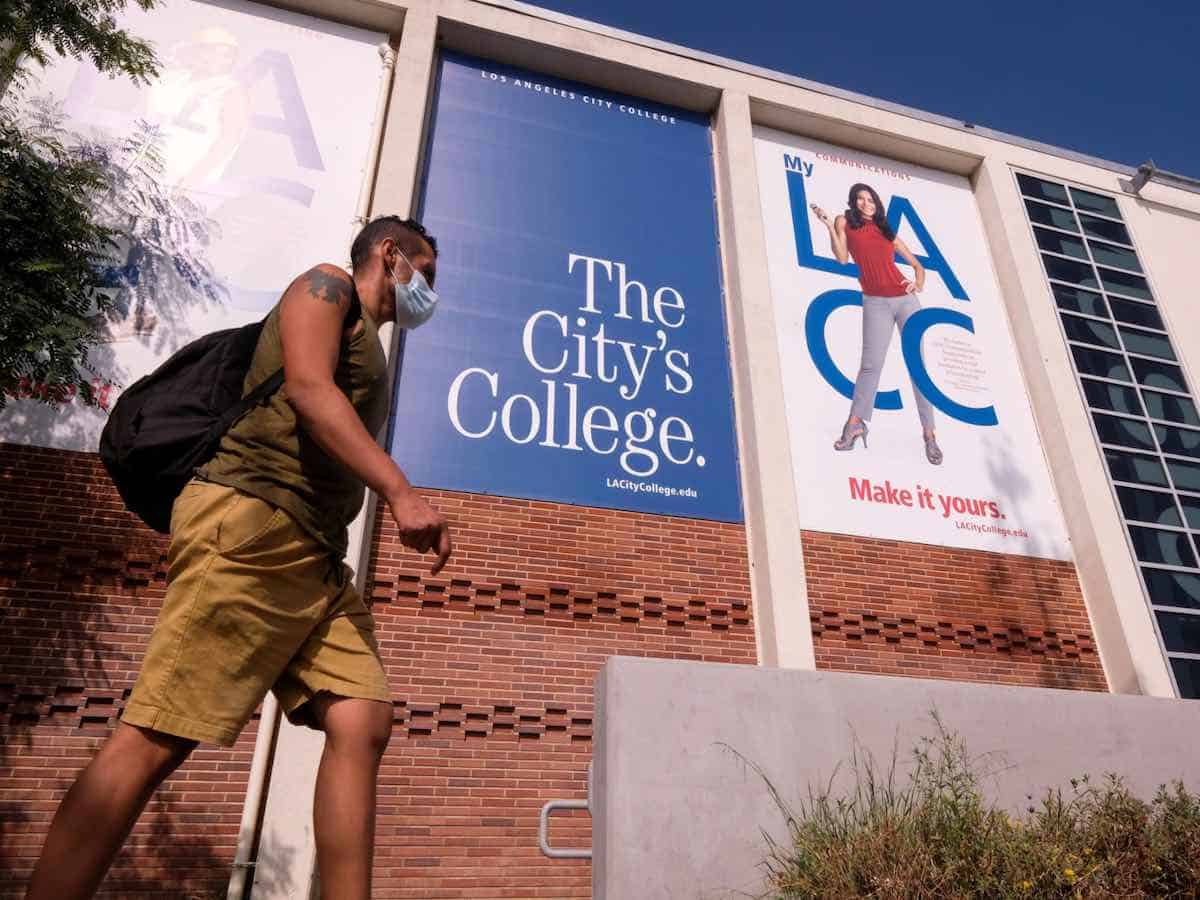
Community Colleges
Junior colleges, associate degrees
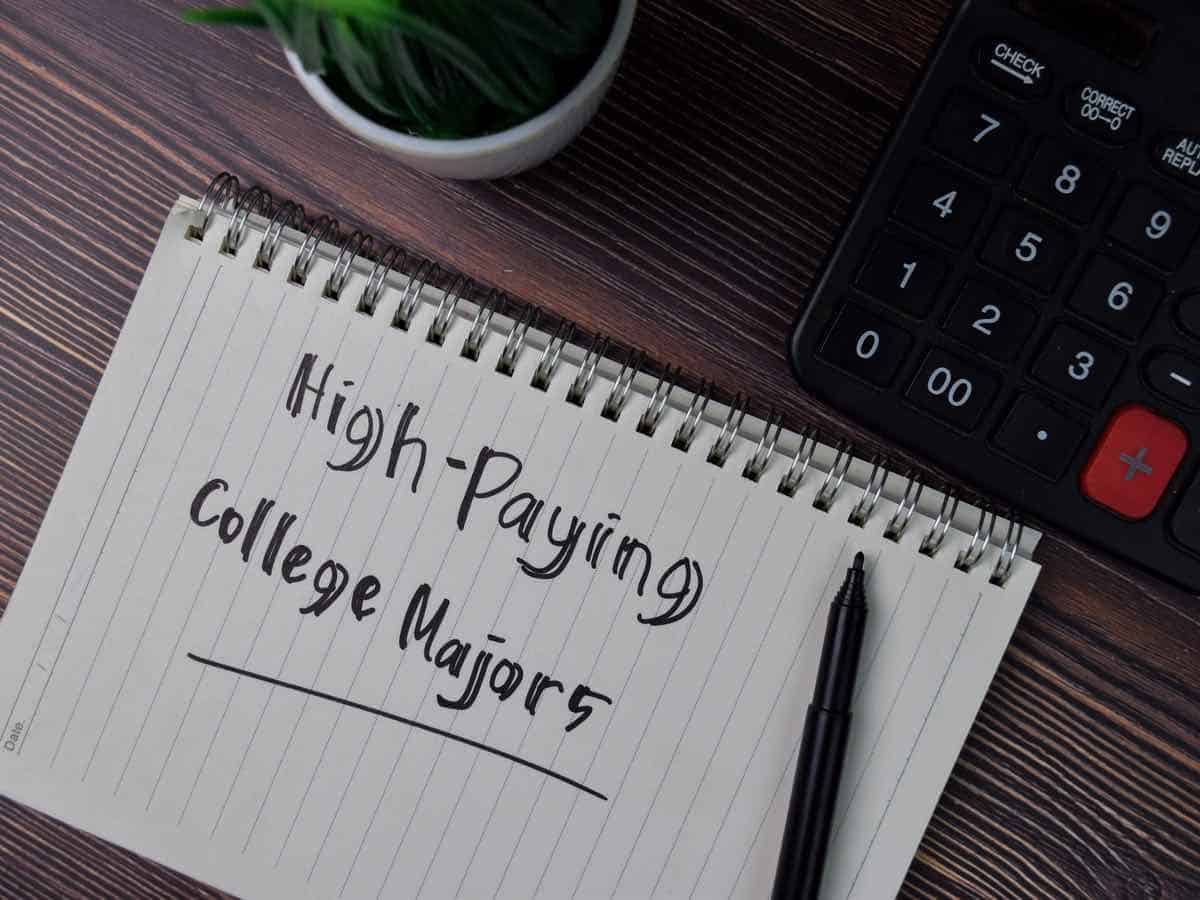
Majors and Minors
Choose the future career path

Stats and Quizzes
Original research and data

“College Reality Check” podcast
These 3 Zodiac Signs Will Have A Reality Check Soon, An Astrologer Says
Brace for impact.

If it feels like you’ve been ignoring a little voice in the back of your head that’s telling you something isn’t quite right or that something needs to change, then a reality check, a wake-up call, or a moment of clarity might be coming your way.
Reality checks can be shocking in the moment, as realizations wash over you or as things fall apart, but they can also be a much-needed catalyst for a fresh start in life. According to Danny Santos , an astrologer and spiritual healer behind Santos & The Crystal Visions , reality checks can come in many forms, too, and it all depends on what planetary movements are happening in your birth chart.
“In astrology, there are many planets and transits that point toward profound clarity or a serious reality check,” he tells Bustle. Usually, it’s the outer planets like Saturn and Pluto , but it can also stem from the asteroid Chiron or the north node , as well as an eclipse cycle . These are the biggest players in terms of major life transitions.
Saturn, for instance, represents karma. When it transits through your sign, it can push you into a period of growth by shining a light on the things you’ve been neglecting. As an example, Santos says you might get fired from your job, but once you learn a few lessons, it could open the door to an even better one.
Pluto also brings with it a sense of transformation, change, and rebirth — and that’s the perfect recipe for a wake-up call. “Pluto’s territory focuses on what needs to be eliminated and will most often involve the shedding of excess baggage, trauma, and energy that no longer serves,” he says. As long as you embrace the change, you could come out the other side feeling brand new.
Below, the three zodiac signs who will have the biggest reality checks soon.
Aries (March 21 - April 19)

“If there was ever a period in an Aries ’ life to experience a completely new lease on their life, now would be the time,” says Santos. That’s because the fateful north node transitioned through the sign of Aries, along with healing Chiron and the solar eclipse on April 8 .
Chiron — a small celestial body also called the “wounded healer” — is said to bring up pain from the past when it transitions through your chart, but it can also help you move on as it teaches you a lessons and triggers major realizations.
According to Santos, this might inspire a dramatic change in your lifestyle, a leap of faith towards new goals, or the ability to embrace your true identity. If you’ve been hiding or repressing something, these transits could inspire you to be your truest, most authentic self.
The recent solar eclipse in Aries has also kicked things in motion. “ Eclipses are times in astrology where the collective astrological page turns and we find ourselves at the activation of a new chapter,” he says. “Not only on the days building up to and after the eclipse do we feel these changes, but eclipse cycles can have important lasting effects for six to 18 months, depending on which eclipse it is.”
April’s solar eclipse cycle activated a 20 year period of enlightenment for Aries, so according to Santos, you can rest assured that you’ll soon have a new lease on life. That said, “the antidote is in the poison,” he says. The only way out is through, so things might feel bumpy before they get better.
Capricorn (Dec. 22 - Jan. 19)

Forget Mercury retrograde . Transformational Pluto is about to retrograde in the sign of Aquarius on May 2, and according to Santos, it will then regress back into Capricorn from September 1 to November 19. In the world of astrology, this is kind of a big deal.
“This retrograde will be the bookend of Pluto’s descent through Capricorn’s chambers since 2008 and complete the cycle of transformation of the lives and placements of Capricorns everywhere over the last 15 years,” he says.
Since you’re an earth sign who prides themselves on hard work and resilience, Pluto’s transit has been making you second guess yourself and your abilities. If you’ve been in a rut of self doubt, your reality check will feel like a brand new burst of confidence, as well as a desire to pick yourself up and move on.
As Santos says, “ Pluto’s retrograde back into this sign will remove the last of Capricorn’s worries by forcing [them] through the final initiation of this transit.” The rest of the year will seem extra magical and enlightening, especially once Pluto ingresses back into Aquarius on November 19th.
Pisces (Feb. 19 - March 20)

“While all mutable signs will feel a particular shift in life direction during the coming months, none will embrace the energy of karmic shifts and progress quite like Pisces ,” says Santos.
As Saturn moves through the sign of the fish, you’ll feel the urge to course correct, take accountability for your actions, and maybe even pick up a new habit or two that’ll reap benefits in the long run.
To take advantage of the moment, Santos says it’s time to get serious about what you want in life, as these planetary transits are going to make it easier than ever to transform into who you want to be. Think about your daily routine, career, friendships, relationships, and anything else that might need to be spruced up.
Along with this Saturn transit, the eclipse on April 8 also showed Mars in conjunction with Saturn, and both were in the sign of Pisces. “As the eclipse took place in Aries — a sign ruled by Mars — Mars’ conjunction to Saturn in Pisces foreshadows a period of action, initiation, and movement,” he says.
Saturn represents structure, stability, and long-term goals, and Mars is traditionally associated with passion and progress. When you add it all together, “Pisces can expect an incredible transformation to occur between now and the upcoming eclipse cycle in September and October.”
Danny Santos , astrologer, spiritual healer
- Newsletters
- Account Activating this button will toggle the display of additional content Account Sign out
I Served on the Florida Supreme Court. What the New Majority Just Did Is Indefensible.
On April 1, the Florida Supreme Court, in a 6–1 ruling, overturned decades of decisions beginning in 1989 that recognized a woman’s right to choose—that is, whether to have an abortion—up to the time of viability.
Anchored in Florida’s own constitutional right to privacy, this critical individual right to abortion had been repeatedly affirmed by the state Supreme Court, which consistently struck down conflicting laws passed by the Legislature.
As explained first in 1989:
Florida’s privacy provision is clearly implicated in a woman’s decision of whether or not to continue her pregnancy. We can conceive of few more personal or private decisions concerning one’s body in the course of a lifetime.
Tellingly, the justices at the time acknowledged that their decision was based not only on U.S. Supreme Court precedent but also on Florida’s own privacy amendment.
I served on the Supreme Court of Florida beginning in 1998 and retired, based on our mandatory retirement requirement, a little more than two decades later. Whether Florida’s Constitution provided a right to privacy that encompassed abortion was never questioned, even by those who would have been deemed the most conservative justices—almost all white men back in 1989!
And strikingly, one of the conservative justices at that time stated: “If the United States Supreme Court were to subsequently recede from Roe v. Wade , this would not diminish the abortion rights now provided by the privacy amendment of the Florida Constitution.” Wow!
In 2017 I authored an opinion holding unconstitutional an additional 24-hour waiting period after a woman chooses to terminate her pregnancy. Pointing out that other medical procedures did not have such requirements, the majority opinion noted, “Women may take as long as they need to make this deeply personal decision,” adding that the additional 24 hours stipulated that the patient make a second, medically unnecessary trip, incurring additional costs and delays. The court applied what is known in constitutional law as a “strict scrutiny” test for fundamental rights.
Interestingly, Justice Charles Canady, who is still on the Florida Supreme Court and who participated in the evisceration of Florida’s privacy amendment last week, did not challenge the central point that abortion is included in an individual’s right to privacy. He dissented, not on substantive grounds but on technical grounds.
So what can explain this 180-degree turn by the current Florida Supreme Court? If I said “politics,” that answer would be insufficient, overly simplistic. Unfortunately, with this court, precedent is precedent until it is not. Perhaps each of the six justices is individually, morally or religiously, opposed to abortion.
Yet, all the same, by a 4–3 majority, the justices—three of whom participated in overturning precedent—voted to allow the proposed constitutional amendment on abortion to be placed on the November ballot. (The dissenters: the three female members of the Supreme Court.) That proposed constitutional amendment:
Amendment to Limit Government Interference With Abortion: No law shall prohibit, penalize, delay, or restrict abortion before viability or when necessary to protect the patient’s health, as determined by the patient’s healthcare provider. This amendment does not change the Legislature’s constitutional authority to require notification to a parent or guardian before a minor has an abortion.
For the proposed amendment to pass and become enshrined in the state constitution, 60 percent of Florida voters must vote yes.
In approving the amendment to be placed on the ballot at the same time that it upheld Florida’s abortion bans, the court angered those who support a woman’s right to choose as well as those who are opposed to abortion. Most likely the latter groups embrace the notion that fetuses are human beings and have rights that deserve to be protected. Indeed, Chief Justice Carlos Muñiz, during oral argument on the abortion amendment case, queried the state attorney general on precisely that issue, asking if the constitutional language that defends the rights of all natural persons extends to an unborn child at any stage of pregnancy.
In fact, and most troubling, it was the three recently elevated Gov. Ron DeSantis appointees—all women—who expressed their views that the voters should not be allowed to vote on the amendment because it could affect the rights of the unborn child. Justice Jamie Grosshans, joined by Justice Meredith Sasso, expressed that the amendment was defective because it failed to disclose the potential effect on the rights of the unborn child. Justice Renatha Francis was even more direct, writing in her dissent:
The exercise of a “right” to an abortion literally results in a devastating infringement on the right of another person: the right to live. And our Florida Constitution recognizes that “life” is a “basic right” for “[a]ll natural persons.” One must recognize the unborn’s competing right to life and the State’s moral duty to protect that life.
In other words, the three dissenting justices would recognize that fetuses are included in who is a “natural person” under Florida’s Constitution.
What should be top of mind days after the dueling decisions? Grave concern for the women of our state who will be in limbo because, following the court’s ruling, a six-week abortion ban—at a time before many women even know they are pregnant—will be allowed to go into effect. We know that these restrictions will disproportionately affect low-income women and those who live in rural communities.
But interestingly, there is a provision in the six-week abortion ban statute that allows for an abortion before viability in cases of medical necessity: if two physicians certify that the pregnant patient is at risk of death or that the “fetus has a fatal fetal abnormality.”
The challenge will be finding physicians willing to put their professional reputations on the line in a state bent on cruelly impeding access to needed medical care when it comes to abortion.
Yet, this is the time that individuals and organizations dedicated to women’s health, as well as like-minded politicians, will be crucial in coordinating efforts to ensure that abortions, when needed, are performed safely and without delay. This is the time to celebrate and support organizations, such as Planned Parenthood and Emergency Medical Assistance , as well as our own RBG Fund , which provides patients necessary resources and information. Floridians should also take full advantage of the Repro Legal Helpline .
We all have a role in this—women and men alike. Let’s get out, speak out, shout out, coordinate our efforts, and, most importantly, vote . Working together, we can make a difference.
- FANNATION FANNATION FANNATION
- SI.COM SI.COM SI.COM
- SI Swimsuit SI Swimsuit SI Swimsuit
- SI Sportsbook SI Sportsbook SI Sportsbook
- SI Tickets SI Tickets SI Tickets
- SI Showcase SI Showcase SI Showcase
- SI Resorts SI Resorts SI Resorts

© Kevin Jairaj-USA TODAY Sports
Luka Doncic's Injury Status for Mavericks vs Clippers Game 5
Luka Doncic is listed on the injury report.
- Author: Farbod Esnaashari
In this story:
Throughout the last week, injuries have been one of the biggest central focuses of the 2024 playoffs, and the series between the LA Clippers and Dallas Mavericks is no different. The latest to be listed on the report is none other than Luka Doncic.
The Dallas Mavericks have officially listed Luka Doncic as probable with a right knee sprain for Game 5 of the Western Conference Quarterfinals against the LA Clippers. Doncic's status is an upgrade from the questionable listing he had in Game 4.
While Luka Doncic hasn't looked quite like himself with a knee sprain, he's still been playing like an All-Star. In Game 4, Doncic put up 29 points, 10 rebounds, 10 assists, and 1 block on 42% shooting from the field in 45 minutes. Throughout the entire series, he's averaged 29.0 points, 9.8 rebounds, and 8.5 assists on 39/27/81 shooting. While Doncic has been more than capable of scoring, his three-point percentages have dramatically dipped. Still, one has to expect that he's due for an onslaught of a game within this series.
The most fascinating thing about this Clippers and Mavericks series thus far is that neither Kawhi Leonard nor Luka Doncic have made all of the heroic highlight plays. Much of this series has been determined by Kyrie Irving, James Harden, and Paul George. It's a much different series than the two that these teams had in 2020 and 2021.
The LA Clippers and Dallas Mavericks face off at 10:00 p.m. EST tonight.
Related Articles
Philadelphia 76ers Star Reveals Honest Feelings on James Harden
Exclusive: Russell Westbrook Opens Up About Role With Clippers
James Harden Opens Up About Playing for Clippers After Rough Few Years
Latest Clippers News

Major Joel Embiid Injury Update Revealed

Clippers Coach Sends Reality Check Message to Team

Paul George's Very Alarming Statement on LA Clippers

Kawhi Leonard's Statement on Russell Westbrook After Loss to Hawks
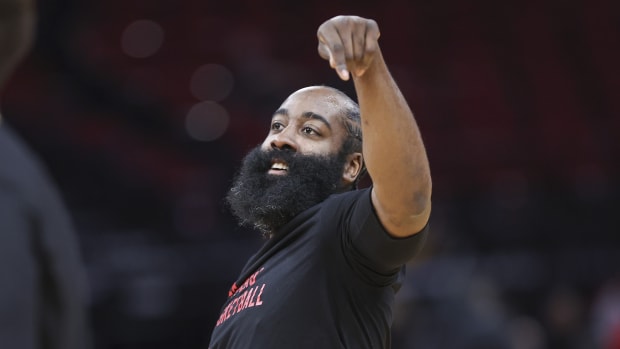
James Harden Makes History During Clippers vs Hawks
Video altered to claim Megyn Kelly admitted she is Nicole Brown Simpson | Fact check

The claim: Video shows Megyn Kelly admitting she is Nicole Brown Simpson
An April 21 Facebook video ( direct link , archive link ) shows side-by-side photos of conservative journalist Megyn Kelly and Nicole Brown Simpson, the slain ex-wife of late football legend O.J. Simpson.
The video cuts to a short clip of Kelly saying, “I am Nicole Brown Simpson.”
The caption reads, “Nicole Brown Simpson Admits She’s Alive As Megyn Kelly!”
The post was shared over 1,000 times in about a week.
More from the Fact-Check Team: How we pick and research claims | Email newsletter | Facebook page
Our rating: Altered
The video was misleadingly edited. The original video shows Kelly debunking, not confirming, a conspiracy theory that she is Brown Simpson, who was found murdered outside of her home in Los Angeles in 1994.
Kelly addressed conspiracy theory during radio show
O.J. Simpson, who was acquitted on charges of murdering Brown Simpson and her friend, Ron Goldman, died on April 11 of prostate cancer.
The next day, Kelly, who hosts " The Megyn Kelly Show " on Sirius XM , addressed on the show viral social media claims that she is Brown Simpson and had not been killed.
The Facebook clip takes Kelly's comments out of context and directs users to a YouTube video about the conspiracy theory. Kelly's full statement shows that she was debunking the rumor.
“There’s a weird thing that I want to talk about," Kelly said. "There is a conspiracy theory, and it’s been around for a long time since I became a public figure, that I am Nicole Brown Simpson. That she and I are actually the same person. This is a thing, you can Google it. And of course, it was all over the place yesterday. It was all over my mentions yesterday, people tweeting pictures of the two of us at me, in my comments."
Kelly reads through some of the social media comments before stating, “I am a real person with a whole independent history having nothing to do with Nicole Brown Simpson, who was very clearly murdered back in 1994.”
Kelly was 23 when Brown Simpson was killed at the age of 35.
Fact check : No, Gates Foundation didn't call math lessons 'racist'
Crime scene photos and the coroner’s testimony during O.J. Simpson’s criminal trial document Brown Simpson's and Goldman's brutal stabbing deaths.
O.J. Simpson was acquitted of both murders on Oct. 3, 1995; however, he was found liable in a civil suit in 1997.
USA TODAY reached out to the user who shared the post for comment but did not immediately receive a response.
Our fact-check sources:
- The Megyn Kelly Show, April 12, Megyn Addresses the Insane Conspiracy Theories That She is Nicole Brown Simpson
- Britannica, accessed April 29, Megyn Kelly
- Biography, accessed April 29, Nicole Brown Simpson
- Los Angeles Times, June 14, 1994, From the Archives: O.J. Simpson’s Ex-Wife Found Stabbed to Death
- The New York Times, June 23, 1994, Nicole Brown Simpson: Slain at the Dawn of a Better Life
- The New York Times, June 8, 1995, Simpson's Wife Faced Killer and Struggled, Coroner Testifies
- OJ Trial Uncut (YouTube), Sept. 22, 2016, OJ Simpson Trial - June 15th, 1995 - Part 1
Thank you for supporting our journalism. You can subscribe to our print edition, ad-free app or e-newspaper here .
USA TODAY is a verified signatory of the International Fact-Checking Network, which requires a demonstrated commitment to nonpartisanship, fairness and transparency. Our fact-check work is supported in part by a grant from Meta .

IMAGES
VIDEO
COMMENTS
Essay. People often face situations that are controlled by different rules. Unfortunately, rules may be inhumane under circumstances in which people may appear. Such a situation happened to Mr. Jones who was trying to get home after a long trip. The case study "Reality Check: Who Makes the Rules?" on page 33 in Chapter 1 discusses his ...
792 Words. 4 Pages. Open Document. My Reality Check. Two things didn't mix well in my life. One was being a full time student and the other an athlete. It was great not having parents around telling you to do your homework or to go to class, of which I never did. I had a choice, which was more important, playing lacrosse or studying.
Guest Essay. Scientists Just Gave Humanity an Overdue Reality Check. The World Will Be Better for It. March 22, 2024.
Reality check: life behind Insta-glam image of 'influencers'. CommonLit does more so that you can spend less. Maximize growth and minimize costs with a partnership for just $3,850 / year! Get a quote for your school. Dismiss Announcement. Text. Paired Texts. Related Media. Teacher Guide.
Check Writing Quality. My reality check is my regular reflective activities about my actions and inactions during my clinical, academic, and social interactions. I also received numerous feedbacks from my colleagues, patients and families, from my preceptors and management of my placement organizations. Their positive and constructive feedback ...
Reality check 2-3 - GREAT ESSAY. GREAT ESSAY. University Miami Dade College. Course. English Composition 1 (ENC1101) 408 Documents. Students shared 408 documents in this course. Academic year: 2022/2023. Uploaded by: Anonymous Student. This document has been uploaded by a student, just like you, who decided to remain anonymous.
My Reality Check Essay My Reality Check Two things didn't mix well in my life. One was being a full time student and the other an athlete. It was great not having parents around telling you to do your homework or to go to class, of which I never did. I had a choice, which was more important, playing lacrosse or studying. Like any first
Unit 5: Reality Check - Persuasive Essay. z. Ample (adj.): more than enough; large, spacious. Be sure to pack ample food and water before starting your camping trip. New security rules require that all airline passengers leave ample time to get to the airport.
Essay Sample Check Writing Quality. ... My first reality check occur when my hometown suffered Hyperinflation that reach 7649.00% in 1990, so you can imagine how bad it was make a living under those circumstances, when right now our economy have a rate of 0.70% of inflation. In this moment I can use the same phrase that our democrat candidate ...
College Reality Check / Application Requirements / Essays. How to Answer Short-Answer Questions in College Application. By Al Abdukadirov December 1, 2023. ... Read More AI and College Admissions essays: Cheating, Plagiarism, Inequality and Other Issues.
Once you're through, scrap the trite word or phrase you opened your conclusion with as well as the rest of the sentence and see how that works. 3. Stating hopes of acceptance. It's no secret that you submitted a college application essay because it's one of the various admissions requirements.
vocabulary. Learn with flashcards, games, and more — for free.
Before writing a supplemental essay, ensure you have researched the college or university enough. Study its values and culture. Examine its alumni members. Look into its programs and facilities. Introspect. It's not enough that you know about the college — it's also a must to explore why you intend to go to it.
REALITY CHECK definition: 1. an occasion that causes you to consider the facts about a situation and not your opinions…. Learn more.
In fact, in 2014, the average annual wage in California was $94,370 with most people making between $64,720 and $120,470. This occupation would allow me to have the kind of life style I want. Other occupations that would fulfill my financial needs include optometrist, registered nurse, and radiologist. According to Career Zone, the average ...
Essay Checker. Home Page; Research; Reality check; Reality check. Sort By: Page 1 of 50 - About 500 essays. Satisfactory Essays. Reality Check. 456 Words; 2 Pages; Reality Check. Reality Check Why do we tend to watch "reality" shows when we know nothing about the show is actual reality? Most reality shows are scripted and portray a negative ...
REALITY CHECK meaning: 1. an occasion that causes you to consider the facts about a situation and not your opinions…. Learn more.
By suppressing questions they considered too 'philosophical', post-war physicists created an unquestioning orthodoxy that influences science to this day.
Reality is simply what it is—nothing more, nothing less. It is said by science that reality is what is most fundamental, and that can be expressed through mathematics. The construction of the entirety of mathematics can be done with an empty set ( The New Scientist ). This nothingness, or blank sheet of existence, is reality.
Word forms: reality checks plural. countable noun [usu sing] If you say that something is a reality check for someone, you mean that it makes them recognize the truth about a situation, especially about the difficulties involved in something they want to achieve. Dylan thinks fans who idolize him need a reality check.
Check The Title. Check whether a specific essay name has been mentioned in the title. In most cases, you lecturer might give you a clue by directly including the type of the essay in the title. You therefore have to take adequate time on each title so that you do not get a hard time when it comes to the identification.
It's good to have a reality check every few months. In February there was a flurry of discussion about whether President Biden's advancing age and seeming weakness in a matchup with Donald ...
© 2024 College Reality Check ® is owned and operated by KIRRIAN ONE, L.L.C., a Maryland limited liability company.
Reality checks can be shocking in the moment, as realizations wash over you or as things fall apart, but they can also be a much-needed catalyst for a fresh start in life.
The Dallas Mavericks are in Los Angeles on Wednesday night for Game 5 against the LA Clippers. This series is tied 2-2, and both sides are dealing with different levels of injury issues.
On April 1, the Florida Supreme Court, in a 6-1 ruling, overturned decades of decisions beginning in 1989 that recognized a woman's right to choose—that is, whether to have an abortion—up ...
This season, Hardaway was averaging 14.4 points, 3.2 rebounds, and 1.8 assists on 40/35/85 shooting. He never really had the chance to play in this playoff series against the Clippers, only ...
While Luka Doncic hasn't looked quite like himself with a knee sprain, he's still been playing like an All-Star. In Game 4, Doncic put up 29 points, 10 rebounds, 10 assists, and 1 block on 42% ...
Welcome to Reality Check Makes You Play Chess Like a Grandmaster. Practice positional, strategy, and tactical play, analyze and look for games of others! Check Out Our Website Puzzles Enhance Chess Skills. These puzzles can range from simple tactics to complex strategic maneuvers, and are designed to improve a player's chess skills.
In reality, Kelly was debunking that rumor. A video of Megyn Kelly was trimmed to make it sound like she admitted to being Nicole Brown Simpson. 📷 Key players Meteor shower up next 📷 Leaders ...